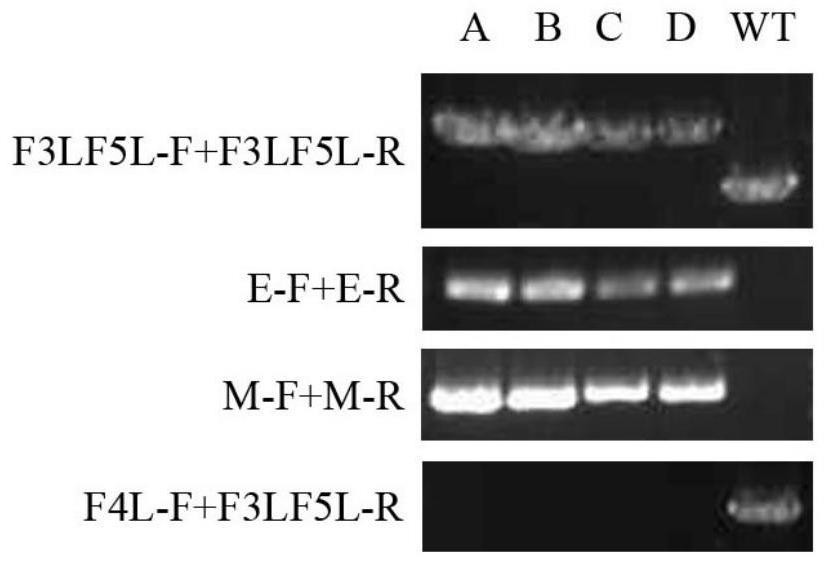Novel coronavirus virus-like particle vaccine based on vaccinia virus vector
A technology of vaccinia virus, virus, applied in the field of biomedicine
- Summary
- Abstract
- Description
- Claims
- Application Information
AI Technical Summary
Problems solved by technology
Method used
Image
Examples
Embodiment 1
[0040] Example 1 Construction of recombinant vaccinia virus F4L-EM expressing new coronavirus E and M proteins
[0041] 1. Method
[0042] 1.1. Acquisition of recombinant virus F4L-EM
[0043] 1.1.1. Reorganization
[0044] 293T cells were seeded in six-well plates (5×10 5 ), cultured overnight, and when the cells grew and spread 60% to 70%, the recombinant plasmid pF4L-EM with the coding gene sequences of the new coronavirus E and M was transfected. After 4 hours, the wild-type virus was infected; after 2 hours, the supernatant was discarded and replaced with fresh complete medium; after 48 hours, the cells were harvested, and freeze-thawed three times to obtain a virus suspension.
[0045] 1.1.2. Purification by virus plaque formation experiment
[0046] Vero (1 × 10 6 ) cells were cultured overnight, and when the cells grew to 80% to 90% of the plate, the collected virus suspension was diluted 10-fold into a six-well plate for infection. After 2 h, the cells were wash...
Embodiment 2
[0056] Example 2 Construction of recombinant vaccinia virus TK-SN / F4L-EM expressing new coronavirus S, N, E, M proteins simultaneously
[0057] 1. Method
[0058] 1.1. Acquisition of recombinant virus TK-SN / F4L-EM
[0059] 1.1.1. Reorganization
[0060] 293T cells were seeded in six-well plates (5×10 5 ), cultured overnight, and when the cells grew and spread 60% to 70%, the recombinant plasmid pTK-SN with the S and N coding sequences of the new coronavirus was transfected. After 4 hours, the recombinant virus F4L-EM expressing E and M was infected; after 2 hours, the supernatant was discarded and replaced with fresh complete medium; after 48 hours, the cells were harvested and freeze-thawed three times to obtain a virus suspension.
[0061] 1.1.2. Purification by virus plaque formation experiment
[0062] Vero (1 × 10 6 ) cells were cultured overnight, and when the cells grew to 80% to 90% of the plate, the collected virus suspension was diluted 10-fold into a six-well p...
Embodiment 3
[0073] Example 3 Construction of TK and F4L-deleted vaccinia virus
[0074] 1. Method
[0075] 1.1. Construction of TK-deficient vaccinia virus
[0076] 293T cells were transfected with the recombinant vector pTK (SEQ ID NO: 4) with the homology arms (J1R, J3R) of the TK region of vaccinia virus, and the wild-type virus was infected after 4 hours; after 2 hours, the fresh complete medium was replaced; after 48 hours , cells were harvested, and freeze-thawed three times to obtain a virus suspension. Multiple rounds of screening and purification were performed using the virus plaque formation experiment, and the purified recombinant virus was amplified and identified by PCR. The specific methods are the same as those in Examples 1 and 2.
[0077] 1.2. Construction of vaccinia virus lacking TK and F4L
[0078] 293T cells were transfected with the recombinant vector pF4L (SEQ ID NO: 3) with homology arms (F3L, F5L) in the F4L region of vaccinia virus, and 4 hours later, the abov...
PUM
 Login to View More
Login to View More Abstract
Description
Claims
Application Information
 Login to View More
Login to View More - R&D
- Intellectual Property
- Life Sciences
- Materials
- Tech Scout
- Unparalleled Data Quality
- Higher Quality Content
- 60% Fewer Hallucinations
Browse by: Latest US Patents, China's latest patents, Technical Efficacy Thesaurus, Application Domain, Technology Topic, Popular Technical Reports.
© 2025 PatSnap. All rights reserved.Legal|Privacy policy|Modern Slavery Act Transparency Statement|Sitemap|About US| Contact US: help@patsnap.com



